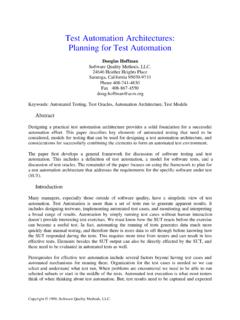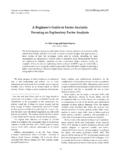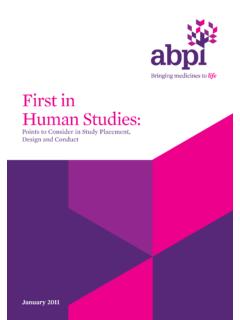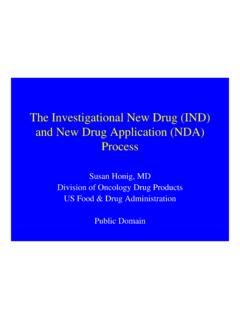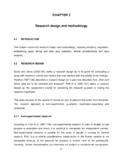Transcription of Cost Benefits Analysis of Test Automation
1 1999, Software Quality Methods, 99 Page 1 of 14 Cost Benefits Analysis of Test AutomationDouglas Hoffman, BACS, MSEE, MBA, CSQES oftware Quality Methods, Heather Heights PlaceSaratoga, California 95070-9710 Phone 408-741-4830 Fax Automated Testing, Automation Tools, Cost of Testing, Intangible Costs, Return on Investment,Tangible Costs Introduction Many managers today expect software test Automation to be a silver bullet; killing the problems of testscheduling, the costs of testing, defect reporting, and more. Automating testing can have positive impacts inmany areas, and there are many success stories to provide hope that test Automation will save money and solvesome testing problems. Unfortunately, there are many more horror stories, disappointments, and bad feelings,even in cases where Automation has been beneficial. I have been brought into more than one situation whereprevious attempts at automating software testing have failed; where large investments have been made inshelfware, and many years of effort creating automated tests abandoned.
2 The purpose of this paper is toprovide some practical guidance for understanding and computing cost and Benefits from test Automation . Itdescribes some financial, organizational, and test effectiveness impacts observed when software test automationis installed. The paper also advises about areas that are difficult or impossible to factor into the financialequations and addresses some common misconceptions management holds about test Automation . There are many factors to consider when planning for software test Automation . Automation changes thecomplexion of testing and the test organization from design through implementation and test execution. It usuallyhas broad impacts on the organization in such things as the tasks performed, test approaches, and even productfeatures. There are tangible and intangible elements and widely held myths about Benefits and capabilities of testautomation. It is important to really understand the potential costs and Benefits before undertaking the kind ofchange Automation implies if only to plan well to make the most of them.
3 Organizational impacts include such things as the skills needed to design and implement automated tests , Automation tools, and Automation environments. Development and maintenance of automated tests is quitedifferent from manual tests . The job skills change, test approaches change, and testing itself changes whenautomation is installed. Automation has the potential for changing the product being tested and the processesused for development and release. These impacts have positive and negative components that must Benefits Analysis of Test Automation 1999, Software Quality Methods, HoffmanPage 2 of 14 Setting realistic expectations in management and understanding where Benefits should be derived from testautomation are key to success. We can easily provide cost justification for proposed Automation if managementdemands numbers. Tool vendors and experts publishing their test Automation strategies provide excellentsources of equations and customer examples justifying almost any approach.
4 In my experience the trick hasbeen to figure out what costs and Benefits really relate to the Automation at hand, and how to make best use ofthem. It is critical to keep in mind that the purpose of test Automation is to do testing better in some is only a means to help accomplish our task testing a product. The Automation itself generally doesnot otherwise benefit the organization any more than the testing does. Cost benefit Analysis provides us withuseful information for deciding how to best manage and invest in testing. There are also many Automation areas that have the potential to provide a benefit or be a drawback dependingon how they are handled. For example, automated tests may reduce staff involvement during testing, thus savingin relation to manually running the same tests . But, automated tests may generate mountains of results that cantake much more staff involvement for Analysis , thus costing more to run than manual tests .
5 Often the informationobtained from automated tests is more cryptic and takes longer to analyze and isolate when faults arediscovered. Existing metrics techniques such as code coverage can be used to estimate or compute test effectiveness beforeand after Automation . Automated tests can be incredibly effective, giving more coverage and new visibility intothe software under test. It also provides us with opportunities for testing in ways impractical or impossible formanual testing, yet conventional metrics may not show any improvements. Automated tests can generate millionsof events and sequences limited only by the machine power and time available for running the tests . These testscan find defects in code already 100% covered. Employing random numbers allows sampling of events andsequences, and also allows tests to do new things every time they are run. Automated probes can look insidethe product being tested at such things as intermediate results, memory contents, and internal program states todetermine if the product is behaving as expected.
6 Some testing can only be accomplished through software test Automation . Computing the cost benefit of asimulated load from a thousand users isn t often necessary. If you need to measure what the system does undersuch a load Automation may be the only other practical way. Testing for memory leaks, checking programinternal state variables, or monitoring tests for unexpected system calls can only be done using paper breaks down the many factors and provides examples of how the elements may be viewed,analyzed, utilized, and measured. The goal is to dispel some of the myths about test Automation and provide apractical approach to deciding what types of investments are worthwhile. Management Perspective There are several areas in which we should set management expectations: intangible costs and Benefits , falselyexpected Benefits , factors common to manual and automated testing, and organizational impacts. We also needto be careful about how we measure and account for things.
7 Cost Benefits Analysis of Test Automation 1999, Software Quality Methods, HoffmanPage 3 of 14 Intangible costs are difficult to realistically assess. Where they can be measured, there is great variation in thefinancial value we place on them. There are also issues in capturing values to measure how much change is dueto Automation . Some of the intangibles are generally positive, some negative, but most can be mixed blessings,depending on one s perspective and how they are done. Due to the difficulties attaching objective values tothese factors, they are best left out of the ROI computation in most cases. Some intangibles: Hands-off testing. Although the cost of people is easily measurable, any additional value ofcomputer control is difficult to quantify. Improved professionalism of test organization. This often increases motivation andproductivity, and comes with the new discipline and tasks Automation requires.
8 Expansion into advanced test issues. This can occur because of the new abilities to test andmonitor that are a consequence of Automation with the improved professionalism. An immediate reduction in perceived productivity of the test organization. This perception isdue to a pause in testing while people ramp up, the lag due to installation of automationtools, and creation of automated tests . Not all members of the test team will want to change. Some turnover in personnel oftenaccompanies test Automation even when some testers continue to test manually. The changes in the quality of tests . The quality may improve or get worse, but manual andautomated tests almost always are different exercises. Numbers of product rolls (test cycles) before release. Automation often allows fasterconfirmation of product builds and may encourage more turns. The churning mayimprove productivity and quality or possibly may cause laziness, lack of attention, anddegradation of quality.
9 Test coverage. It may improve or lessen, depending on the effectiveness of manual testing,the automated tools, and the automated tests . some testing that can only be done through Automation the value of changes in test coverage are difficult to quantify even though we can computemany objective measures of coverage good exploratory testing may cover many more interesting cases than mundane Automation manual testing may encourage situations difficult to manage automatically Management expectations have often been set through the media, vendor hype, conferences, and booksextolling the virtues of test Automation . Some of the information is quite valid and applicable, but much of itunder emphasizes the special circumstances and specific considerations that apply to the projects described andover emphasizes the successes. Test Automation is not a silver bullet. It does not solve all testing problems andhas to be carefully planned to be even marginally successful.
10 Poorly set expectations can result in a beneficialautomation effort getting labeled as a failure. Cost Benefits Analysis of Test Automation 1999, Software Quality Methods, HoffmanPage 4 of 14 Some falsely expected benefits1: All tests will be automated. This isn t practical or desirable. There will be immediate pay back from Automation . An immediate payback may be seen forsome Automation ( , build tests ), but usually the pay back comes much later after theinvestment. It takes a lot of work to create most automated tests and the savings usuallycomes from the running and rerunning after they are created. Automation of existing manual tests . The machine can compound our errors thousands oftimes faster than we can, and computers don t care that their results are ridiculous oruseless. Zero ramp up time. Automating tests takes time. The tools have to be selected, built,installed, and integrated before testing can take place, and planning and implementingautomated tests often take many times the effort of equivalent manual tests .
